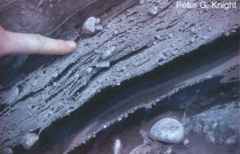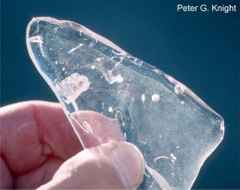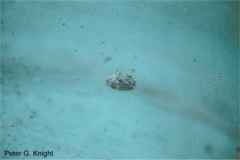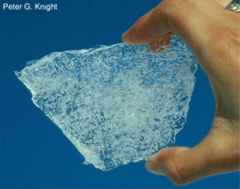| Research on Glaciers Overview of my research |
Overview
Research history
The Low-temperature Laboratory
Overview:
The broad aims of the research are to elucidate the processes by which basal ice is formed, and to use that knowledge to interpret glacial sediments and landforms. Different mechanisms of ice formation, ice diagenesis, debris entrainment and structural deformation generate different physical and chemical characteristics in basal ice. If the relationship between the processes of formation and the characteristics of the ice can be identified, then the basal ice exposed at a glacier margin, or retrieved from a deep ice core, can be used as an indicator of conditions in the inaccessible subglacial zone. In addition, if the basal ice characteristics of ancient glaciers such as those that existed in the UK can be reconstructed from the landforms and sediments they have left behind, then the characteristics of their subglacial environments might also be identified. Go HERE for some photos of basal ice.
     |
I started research in glaciology in 1984, when I started working for my Ph.D in the Department of Geography, University of Aberdeen, with a NERC-funded research studentship under the supervision of David Sugden and Chalmers Clapperton. The project was designed to ascertain the origin of the debris-bearing basal ice exposed in thick sequences at the margin of the Greenland ice sheet, and involved field observations at the Russell Glacier, near Kangerlussuaq, Greenland. The thesis, examined by Geoffrey Boulton, was called "On the origin of debris-bearing basal ice, West Greenland." Stratigraphic, isotopic (oxygen-18 and deuterium), structural, dynamic and sedimentological analyses of ice and debris from the ice-sheet margin indicated two zones of debris entrainment beneath the ice: one in the interior of the ice sheet and one close to the margin. These zones were characterised by different entrainment processes, and hence produced different basal-ice characteristics. Go HERE for some photos of the field area.
Upon completion of the NERC studentship in 1987 I moved to the Department of Geography at Keele University, and continued to develop the work that was started with the PhD. The main results of work stemming more or less directly from the PhD were written up in a series of papers appearing between 1987 and 1994. Key papers from this period include:
-
Knight, P.G. (1987) Observations at the edge of the Greenland ice sheet;
boundary condition implications for modellers. INTERNATIONAL ASSOCIATION
OF HYDROLOGICAL SCIENCES PUBLICATION 170, pp.359-366. click
here for abstract
Sugden, D.E., Knight, P.G., Livesey, N., Souchez, R., Lorrain, R., Tison, J-L and Jouzel, J. (1987) Evidence for two zones of debris entrainment beneath the Greenland ice sheet. NATURE Vol.328 no.6127 pp.238-241.
Knight, P.G. (1988) The basal ice and debris sequence at the margin of an equatorial ice cap; El Cotopaxi, Ecuador. GEOGRAFISKA ANNALER Vol.70A No.1 pp.9-13.
Knight, P.G. (1989) Stacking of basal debris layers without bulk freezing-on: isotopic evidence from West Greenland. JOURNAL OF GLACIOLOGY Vol.35 No.120, pp. 214-216. Click here for abstract.
Knight, P.G. (1992) Ice deformation very close to the ice-sheet margin in West Greenland. JOURNAL OF GLACIOLOGY Vol. 38 no.128 pp3-8
Knight, P.G. (1994) Two-facies interpretation of the basal layer of the Greenland ice sheet contributes to a unified model of basal ice formation. GEOLOGY 22 (11), 971-974. Click here for Abstract
Knight, P.G. (1994) Ice flow around large obstacles as indicated by
basal ice exposed at the margin of the Greenland ice sheet. (with D.E.
Sugden and C.Minty) JOURNAL OF GLACIOLOGY 40 (135), 359-367.
-
Knight, P.G. and Knight, D.A. (1994) Glacier sliding, regelation water
flow, and development of basal ice. JOURNAL OF GLACIOLOGY 40 (136), 600-601.
Click
here for extracts
Knight, P.G. and Knight, D.A. (1999) Experimental observations of subglacial
debris entrainment into the vein network of polycrystalline ice. GLACIAL
GEOLOGY AND GEOMORPHOLOGY http://boris.qub.ac.uk/ggg/papers/full/1999/rp051999/rp05.html
Click here for abstract
-
Knight, P.G. (1997) The basal ice layer of glaciers and ice sheets.
QUATERNARY SCIENCE REVIEWS 16, 975-993. Click
here for abstract
Knight, P.G., Patterson, C.J., Waller, R.I., Jones, A.P. and Robinson, Z.P. (2000) Preservation of basal-ice sediment texture in ice sheet moraines. QUATERNARY SCIENCE REVIEWS 19 (13), 1255-1258.In 2000, I started to develop the "final stage" of my long-term research programme, looking at how basal ice signatures can be identified in formerly glaciated areas such as the UK, and possibly used to identify former subglacial conditions. This involves interests in the moraines marking the southern margin of the former Laurentide ice sheet (working in collaboration with Carrie Patterson) and in the glacial landforms of the English Lake District, as well as continuing work in Greenland with Richard Waller and postgraduate student Will Adam.
read whole paper read abstractKnight, P.G., Waller, R.I., Patterson, C.J., Jones, A.P. and Robinson, Z.P. (2000) Glacier advance, ice-marginal lakes and routing of meltwater and sediment: Russell Glacier, Greenland. JOURNAL OF GLACIOLOGY 46 (154), 423-426.
read abstractKnight, P. G., Patterson, C. J., and Waller, R. I. (2001) Changes in sediment routing as a consequence of ice-sheet advance, Russell Glacier, Greenland. EOS, TRANS. AGU, 82 (47), Fall Meet. Suppl., Abstract. read abstract
Knight, P.G., Waller, R.I., Patterson, C.J., Jones, A.P. and Robinson, Z.P. (2002) Discharge of debris from ice at the margin of the Greenland ice sheet. JOURNAL OF GLACIOLOGY 48 (161), 192-198. read abstract
This work saw it's first published output with:
Adam, W.G. and Knight, P.G. (2003) Identification of basal layer debris in ice-marginal moraines, Russell Glacier,West Greenland. QUATERNARY SCIENCE REVIEWS. (in press) read paper (.pdf file)At the same time, I continued to work on the problem of understanding basal ice formation at present day ice margins, especially at my longstanding field site in Greenland.
In 2003 I was awarded a new grant from the Leverhulme Trust to further develop my basal ice work. The new project involved a combination of field and laboratory work starting with a visit to southern Iceland in summer 2003 and funding Debbie Knight to work as a postdoctoral research assistant in the low-temperature laboratory. First results of this work were presented in Brussels in 2004, and there is more information about this project here. Publications based on this work in the Low-temperature laboratory include:
Knight, P.G. and Knight D.A. (2005) Laboratory observations of debris-bearing ice facies frozen from supercooled water. JOURNAL OF GLACIOLOGYKnight, P.G. and Knight D.A. (2005) Laboratory observations of ice formation and debris entrainment by freezing turbid supercooled water. In Knight, P.G. (ed.) GLACIER SCIENCE AND ENVIRONMENTAL CHANGE (Blackwell, Oxford).
2003-7: Physical Geography at Keele underwent further restructuring, including the appointments of Richard Waller and Zoe Robinson, with whom I was already collaborating, and the organisation of our research under the banner of "Subglacial and Ice Marginal Processes, Landforms and Environments" (SIMPLE) within the School of Physical and Geographical Sciences. Simon Cook was appointed to a PhD studentship and we continued to work in Iceland looking at Glaciohydraulic Supercooling. Publications arising from this work included:
Knight, P.G. and Cook, S.J. (2008) Glaciohydraulic Supercooling. PROGRESS IN PHYSICAL GEOGRAPHY 32 (1), 65-71.
Cook, S.J., Knight, P.G., Waller, R.I., Robinson, Z.P. and Adam, W.G. (2007) The geography of basal ice and its relationship to glaciohydraulic supercooling: Svínafellsjökull, southeast Iceland. QUATERNARY SCIENCE REVIEWS 26 (19-21) 2309-2315.
2008-11: My research at this point was diversifying. I was continuing to pursue the "third stage" of my basal ice work, looking at UK-based glacial landscapes that preserved a signal of former glaciation. This included continuing collaboration with Simon Cook and Richard Waller, and some work with PhD student Aiden Parkes. At the same time I had been looking increasingly at links between glaciology (and geography more generally) and art, collaborating with artist Miriam Burke. I was also by this time getting more involved in pedagogic research, and after my major book project "Glacier Science and Environmental Change" I was also being called upon increasingly to contribute to review works such as substantial encyclopedia entries, and had embarked on a new book-writing project: "Glacier" for Reaktion books.
The Low-Temperature Laboratory
The low-temperature laboratory was developed following my appointment to Keele in 1987. The need for the laboratory arose as a development of my fieldwork-based programme of glacial research. My research since then has combined field observations and laboratory experiments to understand subglacial processes. Field evidence for the internal characteristics of glaciers can be gathered from exposures of debris-bearing basal ice at glacier margins, but models built on this evidence are difficult to test in the field because of the inaccessibility of the subglacial zone. A low-temperature laboratory facility provides the opportunity to test both theoretically-derived and empirically-derived models of glacier processes in a convenient and controlled environment. The main subjects research have been the inaccessible subglacial zone and the englacial hydrological systems of glaciers. Research funded by NERC focussed on the transport of rock debris through the intergranular vein network of polycrystalline glacier ice, and research funded by The Leverhulme Trust focussed on the rapid freezing of supercooled water. In both of these projects Debbie Knight has been funded to work as a post-doctoral researcher in the Lab. Other work that I have supervised in the Lab has included parts of Paul Johnson's and Simon Cook's PhD projects, and a number of undergraduate dissertations.
There is a tradition of laboratory experimentation in glaciology, but it has been confined largely to research in (i) ice physics and chemistry and (ii) simulation of flow and erosion processes. The programme of research being developed at Keele is unusual in that it aims to co-ordinate theoretical and empirical models through the experimental testing of model elements that are inaccessible in the field and cannot rigorously be tested in any other way.
Publications and presenations based on work in the low-temperature laboratory include
Knight, P.G. and Knight, D.A. (1994) Glacier sliding, regelation water flow, and development of basal ice. JOURNAL OF GLACIOLOGY 40 (136), 600-601. Click here for extractsKnight, P.G. and Knight, D.A. (1999) Experimental observations of subglacial debris entrainment into the vein network of polycrystalline ice. GLACIAL GEOLOGY AND GEOMORPHOLOGY
Full paper: http://boris.qub.ac.uk/ggg/papers/full/1999/rp051999/rp05.html
Abstract: click here for abstractKnight, P.G. and Knight, D.A. (2004) Field observations and laboratory simulations of basal ice formed by freezing of supercooled subglacial water. Invited contribution to AMICS (Antarctic ice-sheet dynamics and climatic change: Modelling and Ice Composition Studies) workshop Dynamic Interaction between the Antarctic Ice Sheet and the Subglacial Environment, Vrije Universiteit Brussel, Brussels, April 2004. Sponsored by the Belgian Federal Science Policy Office (BELSPO). Details here
Knight, P.G. and Knight D.A. (2005) Laboratory observations of debris-bearing ice facies frozen from supercooled water. JOURNAL OF GLACIOLOGY
Knight, P.G. and Knight D.A. (2005) Laboratory observations of ice formation and debris entrainment by freezing turbid supercooled water. In Knight, P.G. (ed.) GLACIER SCIENCE AND ENVIRONMENTAL CHANGE (Blackwell, Oxford).